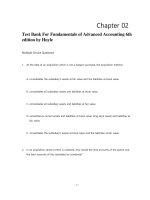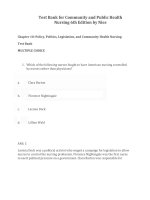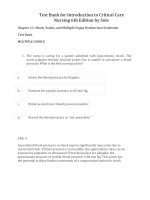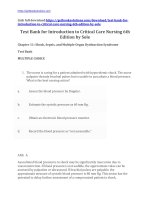Test bank for tietz fundamentals of clinical chemistry 6th edition by burtis
Bạn đang xem bản rút gọn của tài liệu. Xem và tải ngay bản đầy đủ của tài liệu tại đây (50.1 KB, 6 trang )
buy this full document at
Burtis, et al: Tietz Fundamentals of Clinical Chemistry, 6th Edition
Test Bank
Chapter 1: Principles of Clinical Chemistry and Evidence-Based Laboratory
Medicine
MULTIPLE CHOICE
1. During diagnostic accuracy studies in evidence-based laboratory medicine, a laboratory
test being studied, for example, produces results that are compared with the “gold
standard” of testing, which would be the currently used assay or assay system. The test of
interest is referred to as
A. index test.
B. reference standard.
C. outcome study.
D. practice test.
ANS: A
An index test is the method being assessed, and the results of the index test are compared
with the reference standard, which is the current best practice, or method, used to obtain
results.
DIF: 1
REF: Pages 1, 4
OBJ: 5
2. In reading a research article, you determine that the study design was flawed because
there was no control group. This is an example of a weakness in
A. internal reliability.
B. internal validity.
C. external reliability.
D. external validity.
ANS: B
Problems in the design of a study are considered to be poor internal validity and will
produce systematic error because the estimates of diagnostic accuracy differ from those
one would have obtained using an optimal design for the study.
DIF: 2
REF: Pages 1, 4
OBJ: 6
3. When developing clinical practice guidelines, what is the critical first step?
A. Requesting input from health insurance companies and government officials
B. Preparing a cost analysis based on patient needs
C. Determining the intended group that will be directly involved with
implementation
D. Selecting and refining the topic upon which the investigation will center
ANS: D
Selection and refinement of the topic needing investigation must be accomplished before
target groups are chosen and primary evidence is assessed. Scope, topic, and clinical area
must all be addressed within the abilities of the group initiating guideline development.
DIF: 2
REF: Page 13
OBJ: 13
buy this full document at
Full file at />4. Another way that “bias” can be defined is as _____ error.
A. random
B. systematic
C. analytical
D. clinical
ANS: B
Bias is systematic error that occurs when there is constant overestimation or
underestimation of a measured value.
DIF: 1
REF: Pages 1, 4
OBJ: 5
5. Internal validity is
A. the degree to which the variables in the study apply to all individuals in the
study.
B. the degree to which the results of your sample can be inferred to the general
population outside of your study.
C. equal to consistency.
D. is the calculation of mean and variance from repeated measures.
ANS: A
Internal validity is the degree to which the results of a study can be trusted for the
population of patients in the study.
DIF: 1
REF: Pages 1, 4
OBJ: 6
6. A new hormone analyzer is received in the lab. By assaying a control sample 50 times
and assessing the mean and variance of the results, you are checking the _____of the
instrument.
A. sensitivity
B. accuracy
C. validity
D. reliability
ANS: D
Reliability is related to consistency, whereas accuracy and sensitivity are related to
validity. Checking a sample 50 times determines how consistent the analyzer is when
producing results for the same sample.
DIF: 2
REF: Page 2
OBJ: 5 | 6
7. A research study was prepared to assess the diagnostic accuracy of a therapeutic drug
monitoring assay for HMG-CoA reductase inhibitors (statins). The study was flawed with
poor design. Which of the following statements are correct?
A. Random error decreased
B. Systematic error decreased
C. Systematic error increased
D. A and B are both correct.
ANS: C
Poor internal validity caused by poor study design produces systematic error.
DIF: 2
REF: Page 4
OBJ: 5 | 6
Elsevier items and derived items © 2008 by Saunders, an imprint of Elsevier Inc.
Full file at />8. Determine if the following study design is a randomized control trial or a case-control
study: Analysis of leptin in breast milk of obese versus nonobese breast-feeding mothers.
A. Randomized control trial
B. Case-control study
ANS: B
Randomized control studies typically examine a single randomly selected sample, who
are then further randomly assigned to either the treatment group (index) or the control
group (reference). Case-control studies examine two groups, one of which already has the
disease in question (cases) and one that does not (controls).
DIF: 3
REF: Pages 9, 15 OBJ: 9
9. Determine if the following study design is a randomized control trial or a case-control
study: Analysis of the effect of ingestion of one aspirin daily on the platelet count in men
over the age of 60.
A. Randomized control trial
B. Case-control study
ANS: A
Randomized control studies typically examine a single randomly selected sample, who
are then further randomly assigned to either the treatment group (index) or the control
group (reference). Case-control studies examine two groups, one of which already has the
disease in question (cases) and one that does not (controls).
DIF: 3
REF: Pages 9, 15 OBJ: 9
10. Determine if the following study design is a randomized control trial or a case-control
study: Study of the effects of vitamin C ingestion on serum iron concentration in a group
of 30-year-old women.
A. Randomized control trial
B. Case-control study
ANS: A
Randomized control studies typically examine a single randomly selected sample, who
are then further randomly assigned to either the treatment group (index) or the control
group (reference). Case-control studies examine two groups, one of which already has the
disease in question (cases) and one that does not (controls).
DIF: 3
REF: Pages 9, 15 OBJ: 9
11. Determine if the following study design is a randomized control trial or a case-control
study: Assessment of mercury levels in a group of children that live near a toxic waste
dump versus a group of children who live in an urban area.
A. Randomized control trial
B. Case-control study
ANS: B
Randomized control studies typically examine a single randomly selected sample, who
are then further randomly assigned to either the treatment group (index) or the control
group (reference). Case-control studies examine two groups, one of which already has the
disease in question (cases) and one that does not (controls).
DIF: 3
REF: Pages 9, 15 OBJ: 9
Elsevier items and derived items © 2008 by Saunders, an imprint of Elsevier Inc.
Full file at />12. In a randomized control trial, the use of a new vaccine was observed to reduce the
number Chlamydia trachomatis infections in a population of college-aged women. This is
referred to as a(n)
A. clinical audit.
B. systematic review.
C. patient outcome.
D. internal validator.
ANS: C
Outcomes may be defined as results of medical interventions in terms of health or cost.
“Patient outcomes” are results that are perceptible to the patient.
DIF: 2
REF: Pages 1, 6-7 OBJ: 9
13. Continuing with the question above, a physician asks if the results from the therapeutic
drug assay will predict the patient’s eventual health outcome. A study to determine this is
referred to as a
A. patient outcome study.
B. case-control study.
C. systematic review.
D. prognostic value study.
ANS: D
Studies of the prognostic value of a test ask the question, “Can the test be used to predict
an outcome?”
DIF: 1
REF: Page 8
OBJ: 8 | 9
14. Meta-analysis
A. is a statistical technique that compares results from various studies.
B. is an extensive and explicit strategy to find all studies (published or unpublished)
regarding a single assay.
C. includes the quality and the quantity of the health outcome.
D. is a tool to facilitate implementation of lessons from primary studies and
systematic reviews.
ANS: A
Meta-analysis compares assay results obtained from different studies and synthesizes
them by use of statistical techniques.
DIF: 1
REF: Page 11
OBJ: 10
15. Which one of the following is not a component of a clinical audit?
A. Solving problems associated with a process or outcome
B. Monitoring workload in the context of controlling demand
C. Evaluation of the costs of alternative approaches that produce the same outcome
D. Monitoring the introduction of a new test and/or changes in practice
ANS: C
Cost minimization assessment is a methodology of economic evaluation.
DIF: 1
REF: Pages 13, 16 OBJ: 13 | 14
Elsevier items and derived items © 2008 by Saunders, an imprint of Elsevier Inc.
Full file at />16. Following a systematic review, case-control studies, clinical audit, and a cost evaluation,
an assay for assessment of growth hormone level as a predictor of bone cancer has been
recommended by a group of orthopedic surgeons to be performed in your chemistry
laboratory. What is the next step before implementation of the assay?
A. Evaluating the costs of alternative methods to produce similar outcomes
B. Developing a clinical practice guideline for implementation of the assay
C. Performing a meta-analysis
D. Beginning a second round of randomized control trials
ANS: B
For the findings from evidence-based medicine studies to be finally applied, clinical
practice guidelines must be developed to facilitate implementation of what was learned
from primary studies and systematic reviews.
DIF: 3
REF: Pages 13-14 OBJ: 13 | 14
17. Regarding the preceding question, what if anything is inappropriate about the group that
is wishing to develop guidelines for clinical practice and a recommendation to implement
the bone cancer assay?
A. This group would likely not have the expertise needed to suggest implementation
and develop a guideline.
B. This specialty group of physicians might be motivated to implement this test to
produce income for the group practice.
C. The systematic review, research studies, and statistical analysis would be beyond
the scope of this group of physicians.
D. There is nothing inappropriate about this group because they are experts in the
field.
ANS: B
When guidelines are developed by a professional group (such as specialist physicians),
the recommendations may be suspected of promoting the welfare of that professional
group.
DIF: 3
REF: Page 15
OBJ: 13
18. STARD
A. relates to the four components of economic evaluation in an evidence-based
laboratory medicine study.
B. is the assessment of the value of a test analysis for those individuals who are
tested.
C. is a set of guidelines assembled to put into practice the findings of an evidencebased laboratory medicine study.
D. includes a listing of items that need to be included in reports of studies of
diagnostic accuracy.
ANS: D
Standards for Reporting of Diagnostic Accuracy (STARD) is an initiative that intends to
improve reporting the results of diagnostic accuracy studies. The STARD document
includes a checklist of items to be included in diagnostic accuracy studies and a diagram
of study design and participant action.
DIF: 2
REF: Pages 2, 6
OBJ: 7
Elsevier items and derived items © 2008 by Saunders, an imprint of Elsevier Inc.
Full file at />19. QALY
A. is associated with a quality systematic review of literature.
B. assesses the quality of a diagnostic accuracy study.
C. is an outcome expressed in cost-of-intervention analysis.
D. relates to the implementation of the findings of a clinical audit.
ANS: C
A cost-utility analysis of an economic evaluation examines the quality of the life-years
gained. While the cost of the intervention is assessed in monetary terms, the outcomes are
expressed in quality adjusted life years (QALY).
DIF: 2
REF: Page 12
OBJ: 11
20. If the evidence overwhelmingly points toward the introduction of a new laboratory
analysis and practice, yet physicians fail to incorporate the new test into their clinical
practice, what component of evidence-based laboratory medicine will reveal this?
A. Clinical audit
B. Economic evaluation
C. Systematic review
D. Clinical practice guidelines
ANS: A
In applying the principles of evidence-based laboratory medicine to everyday practice,
there must be adherence to the recommendations made by those involved in formulating
new clinical practice guidelines. This commitment is monitored by the clinical audit,
particularly the audit of adherence to best practice.
DIF: 2
REF: Page 17
OBJ: 14 | 15
Elsevier items and derived items © 2008 by Saunders, an imprint of Elsevier Inc.









